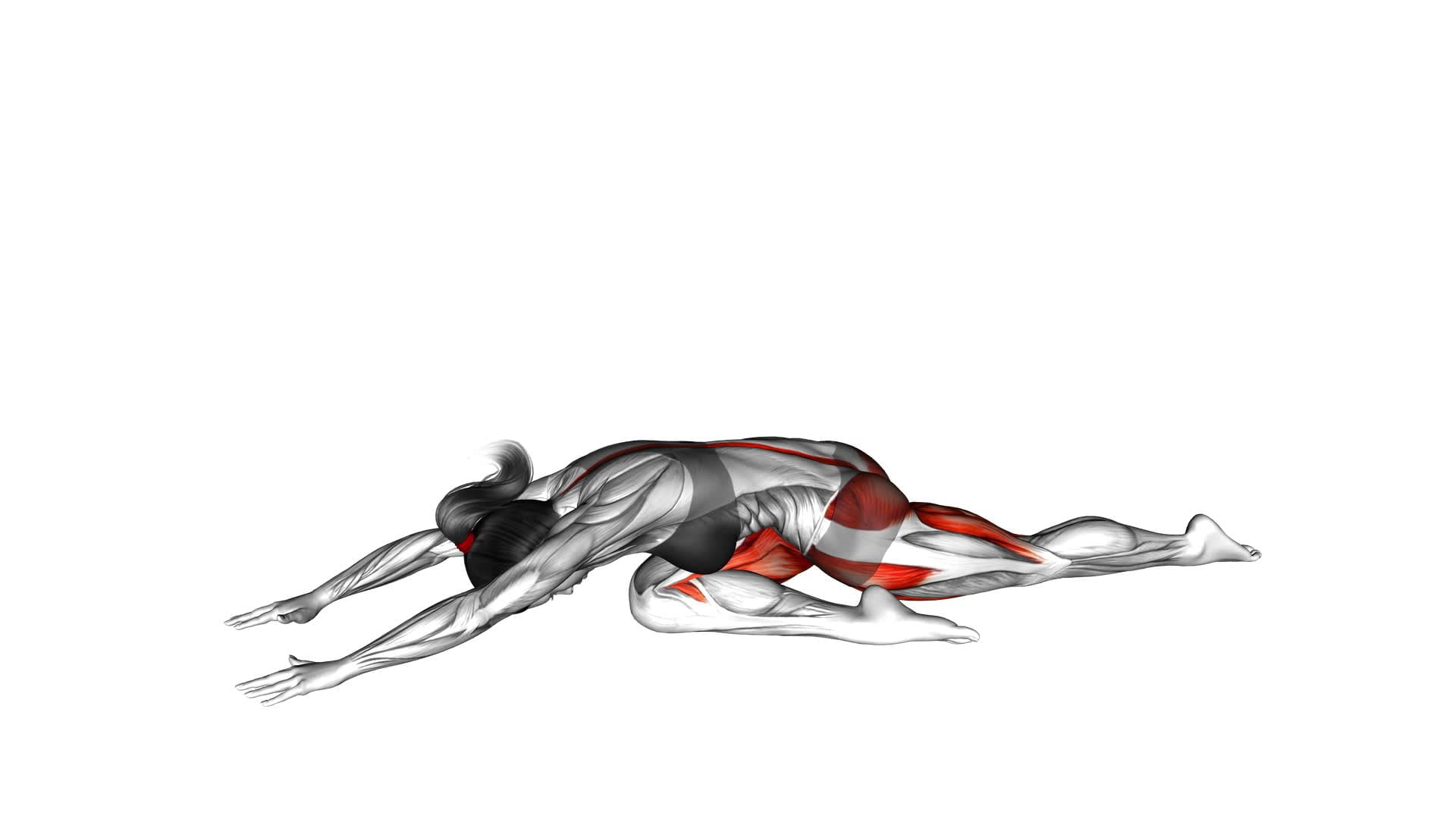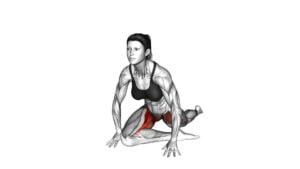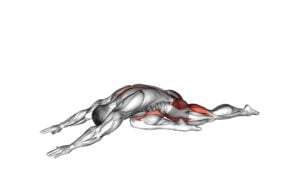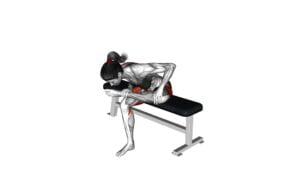Pigeon Hip Stretch (female) – Video Exercise Guide & Tips

Are you looking to improve your hip flexibility and alleviate tightness?
Watch This Exercise Video
In this video exercise guide, we'll walk you through the Pigeon Hip Stretch specifically designed for females.
Learn the proper form and technique, common mistakes to avoid, and modifications for all fitness levels.
Discover tips for maximizing the effectiveness of this stretch and find out how to incorporate it into your workout routine.
Get ready to unlock your hip mobility with our Pigeon Hip Stretch video guide.
Key Takeaways
- The Pigeon Hip Stretch targets the hip flexors and improves flexibility and mobility in the hips.
- It relieves tightness and tension in the hips, promotes proper posture, and enhances range of motion in the hips.
- The stretch can help alleviate lower back pain, reduce the risk of hip and lower back injuries, and relieve sciatic nerve pain.
- Incorporating the Pigeon Hip Stretch into a workout routine can enhance athletic performance, promote relaxation, and aid in stress relief.
Benefits of the Pigeon Hip Stretch
Experience the many benefits of the Pigeon Hip Stretch as you engage in this effective exercise. The Pigeon Hip Stretch is a popular yoga pose that targets the hip flexors and helps improve flexibility and mobility in the hips. This stretch can be modified to accommodate different fitness levels and body types.
One of the key benefits of the Pigeon Hip Stretch is its ability to relieve tightness and tension in the hips. By opening up the hip joints, this stretch can help alleviate discomfort and improve overall hip function. Additionally, the Pigeon Hip Stretch can help improve posture by releasing tension in the lower back and promoting proper alignment.
To maximize the effectiveness of the Pigeon Hip Stretch, it's important to focus on proper form and technique. Start by positioning yourself on the ground with one leg extended behind you and the other leg bent in front of you, with the knee at a 90-degree angle. Make sure to keep your hips squared and avoid any twisting or tilting. If you find it challenging to maintain this position, you can use props such as blankets or blocks to provide support and stability.
Incorporating the Pigeon Hip Stretch into your regular workout routine can have numerous benefits for your hips and overall mobility. By making modifications and following proper form, you can experience the full potential of this effective exercise.
Proper Form and Technique for Females
To ensure proper form and technique for females performing the Pigeon Hip Stretch, focus on maintaining a square and stable position while engaging the hip flexors. This will help improve female flexibility and hip mobility for women. Here are some key points to keep in mind:
- Start by sitting on the floor with your legs bent and your feet flat on the ground.
- Bring your right ankle over your left knee, creating a figure-four shape with your legs.
- Keep your right foot flexed to protect your knee and ankle joints.
- Slowly lean forward while keeping your back straight, feeling a stretch in your right hip.
- Hold the stretch for 20-30 seconds, breathing deeply.
Repeat on the other side, bringing your left ankle over your right knee.
Remember to listen to your body and adjust the intensity of the stretch as needed. Avoid bouncing or forcing the stretch, as this can lead to injury. Incorporate the Pigeon Hip Stretch into your regular routine to improve flexibility and mobility over time.
Common Mistakes to Avoid
To avoid common mistakes while performing the Pigeon Hip Stretch, make sure to maintain proper form and technique.
One of the most common mistakes isn't aligning the front knee properly. Many people tend to let the front knee collapse inward, which can lead to strain on the knee joint. To avoid this, make sure to keep the front knee directly above the ankle, forming a 90-degree angle.
Another common mistake is rounding the back instead of maintaining a neutral spine. Rounding the back not only reduces the effectiveness of the stretch but also increases the risk of injury. To maintain a neutral spine, engage your core muscles and lengthen your spine.
Additionally, it's important to avoid pushing yourself too far into the stretch. Going beyond your comfortable range of motion can strain the muscles and lead to injury. Remember, the Pigeon Hip Stretch is meant to be a gentle stretch, so listen to your body and only go as far as feels comfortable.
Modifications and Variations for All Fitness Levels
To modify the Pigeon Hip Stretch for all fitness levels, you can adjust the depth and intensity of the stretch. Here are some alternative modifications and advanced variations to help you customize the exercise based on your needs:
- Alternative modifications:
- If you're a beginner or have limited flexibility, you can try a seated pigeon stretch. Sit on the floor with one leg extended straight in front of you and the other leg bent, placing the foot on the opposite inner thigh. Lean forward and gently press the bent leg down to feel the stretch in your hip.
- Another modification is using props such as yoga blocks or blankets to support your body in the pigeon pose. This can help you maintain proper alignment and reduce strain on your muscles.
- Advanced variations:
- For a deeper stretch, you can try the king pigeon pose. From the pigeon pose, reach back and grasp your back foot with your hand, pulling it closer to your body. This variation targets not only the hip but also the quadriceps and shoulders.
- Another advanced variation is the flying pigeon pose. Start in a low lunge position, then bend your front knee and place the ankle on the opposite thigh, similar to a pigeon pose. Lift your back leg off the ground and extend it straight behind you, balancing on your hands. This variation challenges your balance and strengthens your core.
Tips for Maximizing the Effectiveness of the Stretch
To maximize the effectiveness of the Pigeon Hip Stretch, it's important to focus on proper form and alignment throughout the exercise. By maintaining proper form, you can ensure that you're targeting the right muscles and avoiding any unnecessary strain on your body. When performing the Pigeon Hip Stretch, make sure to keep your back straight and your hips square to the ground. This will help to maximize flexibility and improve hip mobility.
Another tip for maximizing the effectiveness of this stretch is to breathe deeply and relax into the pose. As you exhale, try to sink deeper into the stretch, allowing your muscles to release tension. Remember to listen to your body and go only as far as your flexibility allows. Over time, with consistent practice, you'll gradually increase your range of motion.
Incorporating the Pigeon Hip Stretch into your workout routine can provide numerous benefits for your overall flexibility and hip mobility. This stretch can be done as a warm-up before other exercises, or as a cool-down after a workout. By making it a regular part of your routine, you can continue to improve your flexibility and mobility over time.
Incorporating the Pigeon Hip Stretch Into Your Workout Routine
To incorporate the Pigeon Hip Stretch into your workout routine, you can benefit from its many advantages. This stretch helps improve hip flexibility, relieves tension in the lower back, and increases range of motion.
To perform the stretch correctly, ensure that your front leg is at a 90-degree angle and your back leg is straight behind you.
Benefits of Pigeon Stretch
You can incorporate the pigeon hip stretch into your workout routine to experience its numerous benefits. Here are some reasons why the pigeon stretch is effective and how you can modify it to suit your needs:
- Pigeon stretch modifications:
- Use a bolster or folded blanket under your hip for added support.
- Place a block under your front thigh for a deeper stretch.
- Use a strap to assist in maintaining proper alignment.
- Pigeon stretch effectiveness:
- Improves hip flexibility and mobility.
- Relieves tension and tightness in the hips and glutes.
- Increases circulation to the hip area, promoting healing and recovery.
Proper Pigeon Stretch Form
After understanding the benefits and modifications of the pigeon stretch, incorporate proper pigeon stretch form into your workout routine to optimize its effectiveness.
When performing the pigeon stretch, start by sitting on the floor with one leg extended behind you and the other leg bent in front of you, creating a 90-degree angle. Keep your back straight and engage your core.
Slowly lower your upper body down towards the floor, resting on your forearms or fully extending your arms. Make sure to keep your hips squared and level.
To deepen the stretch, gently press your bent knee down towards the floor.
Hold the stretch for 30 seconds to one minute and repeat on the other side.
Variations of Pigeon Stretch
Incorporate the pigeon hip stretch into your workout routine to add variation and target your hip muscles effectively. Here are some modifications and benefits of the pigeon stretch:
- Modified pigeon stretch: If you find the traditional pigeon stretch too challenging, you can try using props like yoga blocks or a bolster to support your hips. This will allow you to ease into the stretch and gradually increase flexibility.
- Elevated pigeon stretch: Elevating your front leg on a step or yoga block can intensify the stretch, targeting the hip flexors and glutes even more.
- Dynamic pigeon stretch: Instead of holding the stretch statically, you can incorporate dynamic movements, such as pulsing or rocking back and forth. This can help improve mobility and increase blood flow to the hip muscles.
Benefits of the pigeon stretch include improved hip flexibility, increased range of motion, and reduced tightness in the hip and gluteal muscles.
Frequently Asked Questions
Can Men Also Perform the Pigeon Hip Stretch?
Yes, men can also perform the pigeon hip stretch. It offers various benefits for both men and women, such as improving hip flexibility and reducing tightness.
The pigeon hip stretch can be modified to suit different fitness levels. Beginners can start with a modified version, using props like a block or blanket for support. Advanced practitioners may choose to deepen the stretch by extending the front leg or adding a twist.
How Long Should I Hold the Pigeon Hip Stretch For?
To properly perform the pigeon hip stretch, you need to know how long to hold it for. Holding the stretch for 30 seconds to 2 minutes is recommended. This allows your muscles to fully relax and lengthen.
Incorporating the pigeon hip stretch into your workout routine can be beneficial as it helps improve hip flexibility, increase range of motion, and alleviate tightness in the hips and lower back.
Is the Pigeon Hip Stretch Suitable for People With Hip Injuries?
The pigeon hip stretch is a great exercise for stretching your hips, but it may not be suitable for people with hip injuries. If you have a hip injury, it's important to consult with a healthcare professional before attempting this stretch.
There are alternative stretches that can provide similar benefits without putting strain on your injured hip. It's always best to prioritize your safety and listen to your body when it comes to exercise.
Can the Pigeon Hip Stretch Help Improve Flexibility in Other Areas of the Body?
The pigeon hip stretch can offer various benefits to improve flexibility in other areas of your body. By targeting the hip muscles, this stretch can help release tension and tightness, which can indirectly enhance flexibility in surrounding muscles and joints.
Additionally, there are different variations of the pigeon hip stretch that can further target specific areas like the glutes or lower back.
Including this stretch in your routine can contribute to overall flexibility and mobility.
Are There Any Precautions or Contraindications for Performing the Pigeon Hip Stretch?
Before attempting the pigeon hip stretch, it's important to be aware of any precautions or contraindications. Certain conditions, such as hip or knee injuries, may make this stretch unsuitable for you.
It's always best to consult with a healthcare professional or a qualified fitness instructor to determine if this exercise is safe for you.
Conclusion
Incorporating the pigeon hip stretch into your workout routine can provide numerous benefits for females. By maintaining proper form and technique, avoiding common mistakes, and making modifications to suit your fitness level, you can maximize the effectiveness of this stretch.
Remember to follow the video exercise guide and tips provided to ensure you're getting the most out of your pigeon hip stretch.

Author
Years ago, the spark of my life’s passion ignited in my mind the moment I stepped into the local gym for the first time. The inaugural bead of perspiration, the initial endeavor, the very first surge of endorphins, and a sense of pride that washed over me post-workout marked the beginning of my deep-seated interest in strength sports, fitness, and sports nutrition. This very curiosity blossomed rapidly into a profound fascination, propelling me to earn a Master’s degree in Physical Education from the Academy of Physical Education in Krakow, followed by a Sports Manager diploma from the Jagiellonian University. My journey of growth led me to gain more specialized qualifications, such as being a certified personal trainer with a focus on sports dietetics, a lifeguard, and an instructor for wellness and corrective gymnastics. Theoretical knowledge paired seamlessly with practical experience, reinforcing my belief that the transformation of individuals under my guidance was also a reflection of my personal growth. This belief holds true even today. Each day, I strive to push the boundaries and explore new realms. These realms gently elevate me to greater heights. The unique combination of passion for my field and the continuous quest for growth fuels my drive to break new ground.







